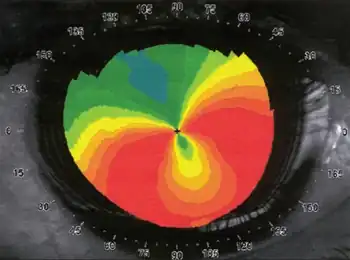Corneal ectatic disorders
| Corneal ectatic disorders | |
|---|---|
 | |
| Axial curvature map shows typical “butterfly wing” pattern of pellucid marginal degeneration | |
| Frequency | Lua error in Module:PrevalenceData at line 5: attempt to index field 'wikibase' (a nil value). |
Corneal ectatic disorders or corneal ectasia are a group of uncommon, noninflammatory, eye disorders characterised by bilateral thinning of the central, paracentral, or peripheral cornea.[1]
Types
- Keratoconus, a progressive, noninflammatory, bilateral, asymmetric disease, characterized by paraxial stromal thinning and weakening that leads to corneal surface distortion.[2]
- Keratoglobus, a rare noninflammatory corneal thinning disorder, characterised by generalised thinning and globular protrusion of the cornea.[3]
- Pellucid marginal degeneration, a bilateral, noninflammatory disorder, characterized by a peripheral band of thinning of the inferior cornea.[4]
- Posterior keratoconus, a rare condition, usually congenital, which causes a nonprogressive thinning of the inner surface of the cornea, while the curvature of the anterior surface remains normal. Usually only a single eye is affected.
- Post-LASIK ectasia, a complication of LASIK eye surgery.[5]
- Terrien's marginal degeneration, a painless, noninflammatory, unilateral or asymmetrically bilateral, slowly progressive thinning of the peripheral corneal stroma.[6]
Diagnosis
Usually diagnosed clinically by several clinical tests. Although some investigations might needed for confirming the diagnosis and to differentiate different types of corneal ectatic diseases.
- Corneal topography
- Corneal tomography
Treatment
Treatment options include contact lenses and intrastromal corneal ring segments for correcting refractive errors caused by irregular corneal surface,[7][8] corneal collagen cross-linking to strengthen a weak and ectatic cornea,[9] or corneal transplant for advanced cases.
References
- ↑ "Corneal ectatic disorders (keratoconus and pellucid marginal degeneration)". AAO ONE Network. American Academy of Ophthalmology. Archived from the original on 2015-02-09. Retrieved 2022-09-19.
- ↑ Weissman, Barry A; Yeung, Karen K (2019-05-30). "Keratoconus". Medscape. Archived from the original on 2017-09-09. Retrieved 2022-09-19.
- ↑ Wallang, B S; Das, S (28 June 2013). "Keratoglobus". Eye. 27 (9): 1004–1012. doi:10.1038/eye.2013.130. PMC 3772364. PMID 23807384.
- ↑ Rasheed, Karim; Rabinowitz, Yaron (2018-12-24). "Pellucid Marginal Degeneration". Medscape. Archived from the original on 2022-12-08. Retrieved 2022-09-19.
- ↑ "Ectasia After LASIK". American Academy of Ophthalmology. Archived from the original on 2022-10-04. Retrieved 2022-09-19.
- ↑ "Terrien marginal degeneration". American Academy of Ophthalmology. Archived from the original on 2015-02-06. Retrieved 2022-09-19.
- ↑ Marsack, Jason D.; Parker, Katrina E.; Applegate, Raymond A. (December 2008). "Performance of Wavefront-Guided Soft Lenses in Three Keratoconus Subjects". Optometry and Vision Science. 85 (12): E1172–E1178. doi:10.1097/OPX.0b013e31818e8eaa. PMC 2614306. PMID 19050464.
- ↑ Marsack, JD; Parker, KE; Niu, Y; Pesudovs, K; Applegate, RA (November 2007). "On-eye performance of custom wavefront-guided soft contact lenses in a habitual soft lens-wearing keratoconic patient". Journal of Refractive Surgery. 23 (9): 960–4. doi:10.3928/1081-597x-20071101-18. PMID 18041254.
- ↑ Avni-Zauberman, N; Rootman, DS (November 2014). "Cross-linking and intracorneal ring segments--review of the literature". Eye & Contact Lens. 40 (6): 365–70. doi:10.1097/icl.0000000000000091. PMID 25320956. S2CID 38858189.
External links
- International Journal of Keratoconus and Ectatic Corneal Diseases Archived 2019-02-19 at the Wayback Machine
This article is issued from Offline. The text is licensed under Creative Commons - Attribution - Sharealike. Additional terms may apply for the media files.